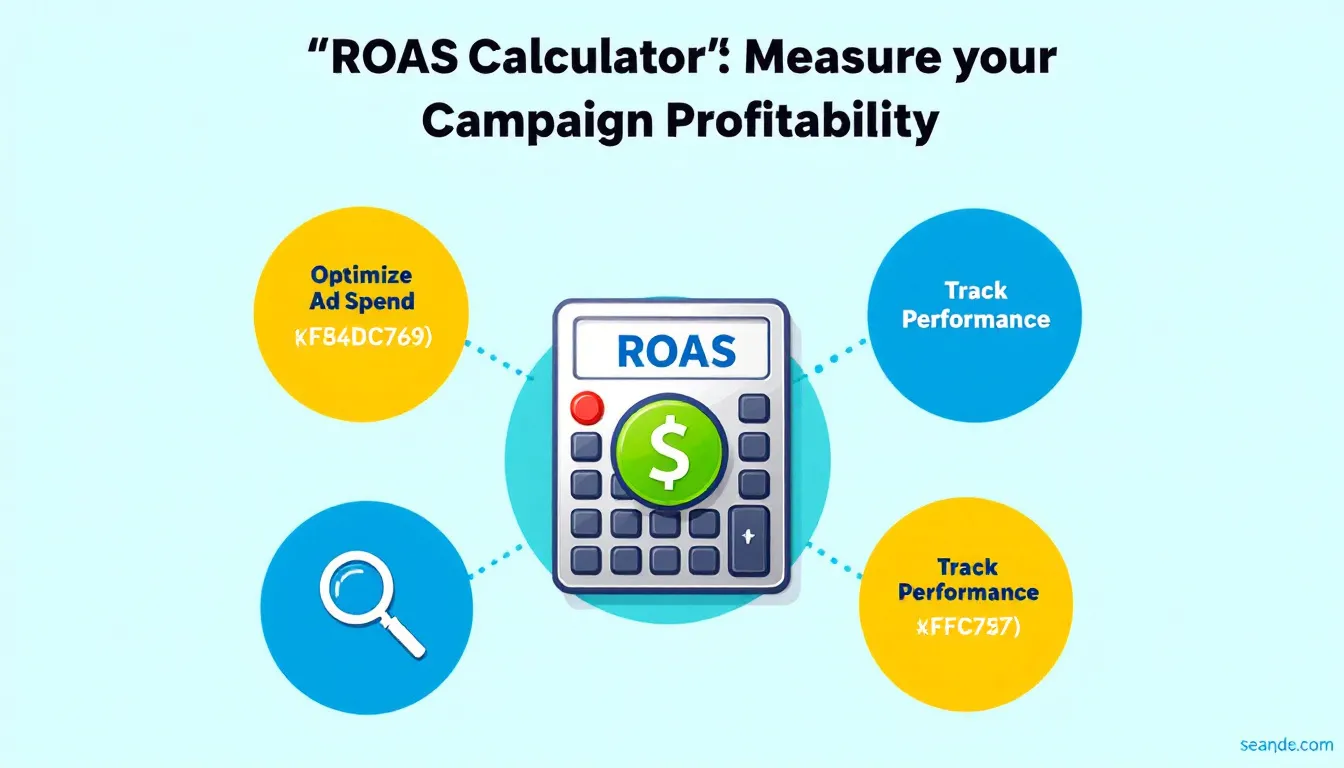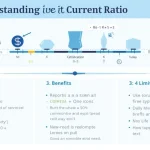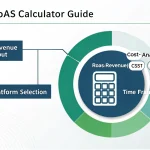ROAS Calculator
Is this tool helpful?
How to Use the ROAS Calculator Effectively
The Return on Ad Spend (ROAS) Calculator is a powerful tool designed to help digital marketers, business owners, and advertising professionals measure the effectiveness of their advertising campaigns. Here’s a step-by-step guide on how to use this calculator efficiently:
- Enter Total Revenue: In the first input field, type in the total revenue generated from your ad campaign. For example, if your campaign resulted in $15,000 in sales, enter “15000” in this field.
- Input Total Ad Spend: In the second field, enter the total amount spent on your advertising campaign. For instance, if you invested $3,500 in ads, type “3500” here.
- Choose Display Format: Select how you’d like the ROAS to be displayed – either as a ratio or a percentage. This allows you to view the results in the format that’s most meaningful to you or your stakeholders.
- Calculate ROAS: Click the “Calculate ROAS” button to process your inputs and generate the results.
- Review Results: The calculator will display your ROAS value and provide an interpretation of what this means for your campaign’s performance.
By following these simple steps, you can quickly assess the efficiency of your advertising efforts and make data-driven decisions to optimize your marketing strategies.
Understanding Return on Ad Spend (ROAS): Definition, Purpose, and Benefits
Return on Ad Spend (ROAS) is a crucial metric in the world of digital advertising that measures the effectiveness of online marketing campaigns. It provides a clear picture of how much revenue is generated for every dollar spent on advertising. Understanding ROAS is essential for businesses of all sizes to evaluate and optimize their marketing efforts.
Definition of ROAS
ROAS is calculated by dividing the total revenue generated from an advertising campaign by the total cost of that campaign. The mathematical formula for ROAS is:
$$ ROAS = \frac{Total\;Revenue\;from\;Ads}{Total\;Ad\;Spend} $$This formula yields a ratio that indicates how many dollars in revenue are earned for each dollar spent on advertising. For example, a ROAS of 5:1 means that for every $1 spent on ads, $5 in revenue was generated.
Purpose of ROAS
The primary purpose of calculating ROAS is to assess the financial effectiveness of advertising campaigns. It helps marketers and business owners to:
- Evaluate the profitability of individual ad campaigns
- Compare the performance of different marketing channels
- Optimize ad spend allocation
- Make data-driven decisions about scaling or pausing advertising efforts
Benefits of Using ROAS
Incorporating ROAS calculations into your marketing strategy offers numerous benefits:
- Improved Budget Allocation: By understanding which campaigns are most effective, you can allocate your advertising budget more efficiently.
- Performance Tracking: ROAS provides a clear metric for tracking the performance of your ads over time.
- Competitive Advantage: Regularly monitoring ROAS allows you to stay ahead of competitors by continuously optimizing your ad spend.
- ROI Insights: ROAS offers a glimpse into the overall return on investment of your marketing efforts.
- Decision-Making Support: With concrete data on ad performance, you can make informed decisions about scaling successful campaigns or cutting underperforming ones.
The Advantages of Using Our ROAS Calculator
Our ROAS Calculator offers several advantages that make it an indispensable tool for marketers and business owners:
1. Time-Saving Efficiency
Manual ROAS calculations can be time-consuming, especially when dealing with multiple campaigns. Our calculator streamlines this process, allowing you to obtain results instantly. This efficiency enables you to spend more time analyzing results and strategizing, rather than crunching numbers.
2. Accuracy and Consistency
Human error in calculations can lead to misguided marketing decisions. Our ROAS Calculator eliminates this risk by providing accurate results every time. This consistency ensures that you’re always working with reliable data when making critical advertising decisions.
3. Flexibility in Result Display
The option to display results as either a ratio or a percentage caters to different preferences and reporting needs. This flexibility allows you to present data in the most appropriate format for your audience, whether it’s for internal team discussions or client presentations.
4. Instant Interpretation
Beyond just providing a numerical result, our calculator offers an immediate interpretation of what your ROAS means. This feature is particularly helpful for those new to ROAS analysis or for quickly understanding the implications of your campaign’s performance.
5. User-Friendly Interface
The clean, intuitive design of our calculator makes it accessible to users of all experience levels. Whether you’re a seasoned marketer or a small business owner new to digital advertising, you’ll find the tool easy to navigate and use.
Addressing User Needs and Solving Specific Problems
Our ROAS Calculator is designed to address several key challenges faced by marketers and business owners in the digital advertising space:
1. Evaluating Campaign Profitability
One of the primary concerns for advertisers is determining whether their campaigns are profitable. Our calculator solves this by providing a clear ROAS value. For instance, if you input a revenue of $25,000 and an ad spend of $5,000, the calculator will show a ROAS of 5, or 500%. This immediately tells you that for every dollar spent, you’re earning $5 in revenue, indicating a highly profitable campaign.
2. Comparing Multiple Campaigns
Marketers often struggle to compare the performance of different campaigns objectively. By using our calculator for each campaign, you can easily compare their ROAS values. For example:
- Campaign A: Revenue $10,000, Ad Spend $2,000 = ROAS 5 (500%)
- Campaign B: Revenue $8,000, Ad Spend $1,000 = ROAS 8 (800%)
This comparison clearly shows that Campaign B is more efficient in terms of ad spend, despite generating less total revenue.
3. Setting Benchmarks and Goals
Our calculator helps in establishing performance benchmarks and setting realistic goals. If your current ROAS is 3 (300%), you might set a goal to improve it to 4 (400%) in the next quarter. The calculator allows you to experiment with different revenue and ad spend scenarios to determine what’s needed to achieve this goal.
4. Justifying Marketing Budgets
When presenting to stakeholders or clients, justifying ad spend can be challenging. Our ROAS Calculator provides concrete data to support budget requests. If you can show that a $10,000 ad spend resulted in a ROAS of 6 (600%), or $60,000 in revenue, it becomes much easier to argue for maintaining or increasing the advertising budget.
5. Identifying Underperforming Campaigns
The calculator helps quickly identify campaigns that aren’t meeting expectations. If your target ROAS is 4, but a campaign shows a ROAS of only 1.5, it’s a clear signal that the campaign needs optimization or reconsideration.
Practical Applications and Use Cases
The ROAS Calculator has wide-ranging applications across various industries and marketing scenarios. Here are some practical use cases:
1. E-commerce Product Launches
An online retailer launching a new product line can use the ROAS Calculator to assess the effectiveness of their launch campaign. By inputting the revenue generated from the new products and the ad spend for the launch campaign, they can determine if the marketing efforts were cost-effective and adjust future strategies accordingly.
2. Seasonal Campaign Optimization
A travel agency running holiday season promotions can use the calculator to compare the ROAS of different vacation package ads. This allows them to quickly identify which packages are resonating most with their audience and allocate more budget to the top-performing ads.
3. Multi-Channel Marketing Analysis
A B2B software company advertising across multiple channels (e.g., LinkedIn, Google Ads, and industry-specific websites) can use the ROAS Calculator to compare the performance of each channel. This insight helps in optimizing the marketing mix and focusing resources on the most effective platforms.
4. Influencer Marketing ROI
Brands engaging in influencer marketing can use the calculator to assess the return on their influencer partnerships. By inputting the revenue attributed to an influencer’s promotional efforts and the cost of the collaboration, brands can determine which influencer partnerships are most valuable.
5. Local Business Advertising
A local restaurant running geo-targeted ads on social media can use the ROAS Calculator to evaluate the effectiveness of their local advertising efforts. This helps in deciding whether to expand their advertising radius or focus on more targeted local promotions.
Frequently Asked Questions (FAQ)
Q1: What is a good ROAS?
A: Generally, a ROAS of 4:1 ($4 in revenue for every $1 spent on advertising) is considered good in many industries. However, what constitutes a “good” ROAS can vary depending on your business model, profit margins, and overall marketing goals. Some businesses may aim for a higher ROAS, while others might be satisfied with a lower ratio if it aligns with their growth strategy.
Q2: How often should I calculate my ROAS?
A: It’s recommended to calculate your ROAS regularly, typically on a weekly or monthly basis for ongoing campaigns. For short-term campaigns, you might want to calculate ROAS more frequently. Regular monitoring allows you to make timely adjustments to your advertising strategy.
Q3: Can ROAS be negative?
A: ROAS itself cannot be negative because it’s a ratio of revenue to ad spend. However, if your ad spend exceeds your revenue, your ROAS will be less than 1, indicating that you’re losing money on your advertising efforts.
Q4: How is ROAS different from ROI?
A: While both metrics measure the effectiveness of investments, ROAS focuses specifically on advertising spend, while ROI (Return on Investment) takes into account the total cost of an investment, including factors beyond just advertising costs. ROAS is typically expressed as a ratio or percentage, while ROI is usually expressed as a percentage.
Q5: Should I always aim for the highest possible ROAS?
A: Not necessarily. While a high ROAS is generally positive, it’s important to balance it with other business objectives. Sometimes, a lower ROAS might be acceptable if it’s contributing to other goals like market expansion or brand awareness. It’s crucial to consider ROAS in the context of your overall business strategy.
Q6: Can I use ROAS to compare different types of advertising channels?
A: Yes, ROAS is an excellent metric for comparing the performance of different advertising channels. It provides a standardized way to evaluate the efficiency of various platforms, whether you’re comparing social media ads, search engine marketing, or traditional advertising methods.
Q7: How does ROAS help in budget allocation?
A: ROAS helps in budget allocation by showing which campaigns or channels are generating the most revenue relative to their cost. By identifying high-ROAS campaigns, you can allocate more budget to these effective strategies, potentially increasing overall profitability.
Q8: Is a high ROAS always sustainable?
A: While a high ROAS is desirable, it may not always be sustainable in the long term. Factors like market saturation, increased competition, or changes in consumer behavior can impact ROAS over time. It’s important to continually monitor and adjust your strategies to maintain a healthy ROAS.
Q9: How can I improve my ROAS?
A: To improve your ROAS, consider the following strategies:
- Optimize your targeting to reach more relevant audiences
- Improve your ad creatives and copywriting
- Refine your landing pages to increase conversion rates
- Test different ad formats and placements
- Adjust your bidding strategies
- Focus on high-performing keywords or audience segments
Q10: Can ROAS be used for offline advertising?
A: Yes, ROAS can be applied to offline advertising, though it may be more challenging to track. For offline campaigns, you’ll need to implement systems to accurately attribute revenue to specific advertising efforts. This might involve using unique promo codes, dedicated phone lines, or surveys to track how customers learned about your product or service.
By leveraging our ROAS Calculator and understanding its applications, you can make more informed decisions about your advertising strategies, ultimately leading to more effective and profitable marketing campaigns.
Important Disclaimer
The calculations, results, and content provided by our tools are not guaranteed to be accurate, complete, or reliable. Users are responsible for verifying and interpreting the results. Our content and tools may contain errors, biases, or inconsistencies. We reserve the right to save inputs and outputs from our tools for the purposes of error debugging, bias identification, and performance improvement. External companies providing AI models used in our tools may also save and process data in accordance with their own policies. By using our tools, you consent to this data collection and processing. We reserve the right to limit the usage of our tools based on current usability factors. By using our tools, you acknowledge that you have read, understood, and agreed to this disclaimer. You accept the inherent risks and limitations associated with the use of our tools and services.







